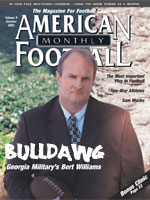AMERICAN FOOTBALL MONTHLY THE #1 RESOURCE FOR FOOTBALL COACHES
Article CategoriesAFM Magazine
|
Using The Inside Screen as a Weaponby: Curt WieseOffensive Coordinator, Marietta College © More from this issue It is an honor to have the opportunity to be a part of what I feel is the best football publication in the world. I have had the chance to read American Football Monthly religiously in my collegiate coaching career. I will be a first-year offensive coordinator at Marietta College. I came from the University of Wisconsin-Eau Claire where I began coaching tight ends as a graduate assistant and eventually became an offensive line coach. I have enjoyed playing and coaching on the offensive side of the ball. I enjoy attempting to outthink our opponent with personnel and formation changes. Our philosophy on offense will be to move the chains with misdirection in our formations and our personnel substitutions. We will use our screen package out of 12 different base formations a....The full article can only be seen by subscribers. Subscribe today!
|
|
|||||||
| HOME |
MAGAZINE |
SUBSCRIBE | ONLINE COLUMNISTS | COACHING VIDEOS |
Copyright 2025, AmericanFootballMonthly.com
All Rights Reserved





